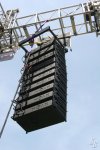The goal of rigging is to defy gravity for a relatively short amount of time, and not kill or injure anyone or anything in the process.
One of the basic concepts of rigging is that you want to apply a load so it will compress the "beam" rather than putting it into tension. That's the reason you would attach the load to the TOP chords of the truss, compression. In the picture you see the bottom truss chords in tension, and note that at the node (where the 2 diagonal "laces" form an apex, up or down) the lacing is all that holds the load, whereas if you load the truss from the top chords the lacing spreads the load to the bottom chords. This is dangerous and the roof technician should not have allowed it.
Also note that the speaker array is connected directly to the horizontal truss. The array should have its own hoist(s) rigged from the horizontal. It appears this is a sound bay that is part of a roof system (look in the upper left corner). That means an asymmetrical and unbalanced lift; it means that if the PA needs trimmed in due to weather the whole roof comes down with it. I won't say this is patently unsafe, but I will say we don't do things that way in our shop.
Shameless plug: check out the Event Safety Alliance. Really.
Shameless plug #2: get the Donovan book. Double really. Reading it won't make you a rigger but you'll be able to intelligently discuss your particular needs with a rigger. You'll be able to identify some dodgy practices and poor materials choices. Hopefully you'll never see those on *your* gigs.




